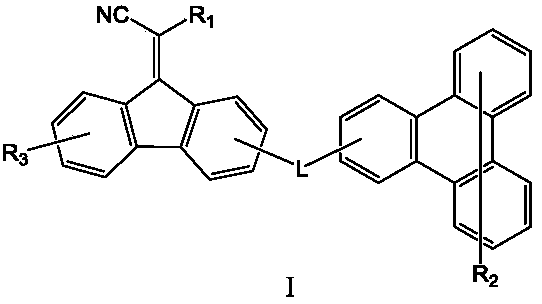Fluorene derivative and organic electroluminescent device thereof
A technology of electroluminescent devices and fluorene derivatives, which is applied in the field of fluorene derivatives and organic electroluminescent devices, can solve the problems of reduced luminous efficiency of devices, reduced probability of exciton recombination, and unstable light color of devices. Achieve good luminous efficiency and life performance, reduce energy accumulation, and improve light color stability
- Summary
- Abstract
- Description
- Claims
- Application Information
AI Technical Summary
Problems solved by technology
Method used
Image
Examples
Embodiment 1
[0090] [Example 1] Synthesis of Compound A-1
[0091]
[0092] Step1: Under the protection of nitrogen, the compound 2-bromo-9-fluorenone (2.59g, 10mmol) was added to the reactor and completely dissolved in 50mL DMF solution, stirred at room temperature, and then malononitrile (0.79g, 12mmol) was added, Stir the reaction at room temperature for 1 h, add deionized water to stop the reaction after the reaction, stir for 10 min, filter to obtain the precipitate, dilute the precipitate with ethyl acetate, anhydrous MgSO 4 Dry, filter, concentrate, and go through silica gel column chromatography to obtain intermediate A-1-1 (1.66 g, 54%).
[0093] Step2: Under nitrogen, add intermediate A-1-1 (3.07g, 10mmol), triphenylene-2-boronic acid (2.72g, 10mmol), tetrakistriphenylphosphine palladium (0.12g, 0.1 mmol), sodium carbonate (4.14g, 30mmol), toluene 100mL, ethanol 20mL and distilled water 20mL, stirred and refluxed for 3h. After the reaction was finished, stop the reaction wit...
Embodiment 2
[0094] [Example 2] Synthesis of Compound A-3
[0095]
[0096] Step1: Add hexafluorobenzonitrile (1.93g, 10mmol), ethyl cyanoacetate (1.11g, 10mmol), potassium carbonate (1.67g, 12.1mmol), 30mL of DMF into the reactor, stir the reaction at room temperature for 48h, then add Distilled water and acetic acid terminated the reaction, extracted with dichloromethane and concentrated to obtain intermediate A-3-1 (2.83 g, 99%).
[0097] Step2: Add intermediate A-3-1 (2.86g, 10mmol), 50% acetic acid (4.10mL) and sulfuric acid (0.2mL) to the reactor, stir after reflux for 16h, cool the mixture to room temperature, add dropwise 10mL of cold distilled water After the reaction was terminated, the mixture was stirred for 0.5 h, and the reaction mixture was extracted with distilled water and chloroform, and then concentrated to obtain intermediate A-3-2 (2.06 g, 96%).
[0098] Step3: Under nitrogen protection, add 2-bromo-9-fluorenone (2.59g, 10mmol), intermediate A-3-2 (2.57g, 12mmol) a...
Embodiment 3
[0100] [Example 3] Synthesis of Compound A-19
[0101] Compound A-19 (5.63 g, 78%) was obtained according to the synthesis method of compound A-3.
[0102]
PUM
 Login to View More
Login to View More Abstract
Description
Claims
Application Information
 Login to View More
Login to View More - R&D
- Intellectual Property
- Life Sciences
- Materials
- Tech Scout
- Unparalleled Data Quality
- Higher Quality Content
- 60% Fewer Hallucinations
Browse by: Latest US Patents, China's latest patents, Technical Efficacy Thesaurus, Application Domain, Technology Topic, Popular Technical Reports.
© 2025 PatSnap. All rights reserved.Legal|Privacy policy|Modern Slavery Act Transparency Statement|Sitemap|About US| Contact US: help@patsnap.com



